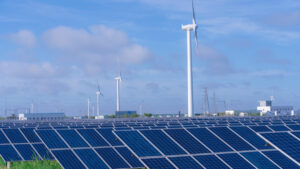These green hydrogen stocks are gaining momentum but domestic demand is ‘crucial’

Pic: Kevin Winter/Getty Images for Coachella
- Big opportunities lie with green hydrogen but as it stands the cost of production (upwards of $10) poses a great challenge
- Ongoing policy support including innovative ways to incentivise the market is critical
- Peak Asset Management’s Ali Ukani provides us with his 3 top green hydrogen picks to play the thematic
Globally we are seeing the unprecedented momentum for hydrogen turn into action, but experts say the adoption of ‘green hydrogen’ is expected to ramp-up beyond 2030 as the cost of production approaches the $2/kg mark.
As it stands, when it comes to hydrogen – grey, blue, and green are currently the three main competitors.
Grey hydrogen is created from natural gas, or methane, using steam methane reformation but without capturing the greenhouse gases made in the process.
Blue hydrogen is essentially the same process, but with the addition of capturing the resulting carbon dioxide and storing it deep underground – also known as carbon, capture and storage (CCS).
One shot opportunity – go green
But the big opportunities are in green hydrogen, which is made using clean electricity from renewable energy sources, such as solar or wind power to power electrolysers that use an electrochemical reaction to split water into its components of hydrogen and oxygen.
Importantly, this process has zero carbon emissions.
It is believed the clean fuel will be a massive industry of its own in the next decade, used to generate electricity, fuel vehicles, produce chemicals and heat as well as being a key transition pillar in hard to abate sectors.
Highlighting this, Fortescue Future Industries (FFI) – the green arm of Fortescue Metals Group (ASX:FMG) and one of the first big movers in the space – is establishing a portfolio of domestic and international projects with an ambitious target to supply 15Mt of green hydrogen by 2030 before reaching 50Mt thereafter.
Bahador Tari is an associate and hydrogen lead at Energetics, a climate and energy risk management consultancy developing approaches for ASX200 and all levels of government.
Right now, he says the economics of green hydrogen are challenging – the holy grail of hydrogen is producing it between $2–$3 a kilo but at the moment it is upwards of $10.
“The cost of green hydrogen produced from electrolysis is currently 2-3 times more expensive than the incumbent fossil-fuel based pathway and for hydrogen to achieve uptake, ongoing policy support including innovative ways to incentivise the market is critical.”
Increasing domestic low-carbon hydrogen demand
In most jurisdictions, including Australia, the focus of most government policies has been on producing low-carbon hydrogen.
“Measures to increase demand have not received the same level of attention,” Tari explains.
“If hydrogen demand is not sufficiently stimulated, producers may not be able to secure off-takers, which will impede market development.”
Some new policy instruments Australia could consider as a means to enhance domestic demand include the German government’s H2 Global Program, where the government is set to tender 10-year purchase agreements on hydrogen-based products, providing certainty to investors on project bankability.
Hydrogen certification and the guarantee of origin will be another vital component for the sourcing of hydrogen as the clean hydrogen economy continues to gain scale, Tari adds.
To demonstrate the ‘green’ credentials of their product(s), developers would need to certify their products to provide greater transparency and credibility to their customers, thereby mitigating potential demand risk.
Why is green hydrogen so expensive?
Peak Asset Management’s Ali Ukani says it comes down to two factors – input energy cost and cost of the electrolyser.
“While we do have excess renewables available in various parts of the country, they’re not always accessible for H2 production,” he says.
“There is also the issue of intermittency, which requires further investment in battery storage infrastructure.
“The electrolysers also have a number of hurdles to overcome, including the input of precious metals in polymer electrolyte membrane (PEM) stack and so on.
“It is pivotal to significantly reduce this cost whilst increasing scalability to yield favourable unit economics but ultimately for green hydrogen to be a market leader, we need to reduce the levelised cost of electricity (LCOE).”
Green hydrogen stocks to watch
As with any nascent industry, the hydrogen market will go through ebbs and flows but Ukani says as 2030 nears closer, that $2-3 per kilo target will be met.
“Hydrogen is a buy, but only when you understand what the company is doing and where it is at in the life cycle,” he said.
A good place to start is checking out Ukani’s three top green hydrogen picks.
Renu Energy (ASX:RNE)
RNE has recently completed the 100% acquisition of Countrywide Renewable Hydrogen, which focuses on renewable hydrogen production opportunities with top-tier operators.
It has three projects in the pipeline, targeting domestic and export demand including a renewable hydrogen project in Tasmania’s north involving a 10MW pilot project producing 4.5 tonnes per day for domestic use in the transportation sector.
The Melbourne Hydrogen Hub will comprise renewable hydrogen production, vehicle refuelling, service and maintenance, injection into the natural gas network and a fuel cell bus fabrication plant which will supply buses to the participating companies.
And lastly, CRH is developing a renewable hydrogen project in Portland, Victoria, where stage one includes a 10MW electrolyser supplying hydrogen to local mobility and gas markets.
The second stage will involve an expansion to at least 250MW to supply hydrogen or its derivatives to Japan and Korea.
Lion Energy (ASX:LIO)
Next on Ukani’s list is LIO, a company involved in green hydrogen production, storage, and distribution in Australia.
“Lion Energy captures a different part of the hydrogen supply chain, focusing on the transportation,” he said.
“Together with its partners, the company envisions building and operating a network of hydrogen production hubs and refuelling stations.”
In the March quarter, LIO continued to develop its business case for green hydrogen by progressing a proposal with BLK Auto – Australia’s first supplier of hydrogen fuel cell powered coaches – and with Pulitano Group, a transport and property group with city bus and coach operations in Queensland and Victoria.
Environmental Clean Technologies (ASX:ECT)
ECT recently signed a joint venture agreement with Graphenex to support the rollout of phase two of the company’s Bacchus Marsh COLDry Project – a commercial scale net-zero hydrogen and electricity production.
The JVA will enable the first-of-a-kind demonstration of low emission electricity production from syngas and the generation of hydrogen derivative products from lignite and waste biomass blends, making it the largest demonstration of its kind in Australia.
Low emission electricity production from syngas and the generation of hydrogen derivative products from lignite and waste biomass blends will make it the largest demonstration of its kind in Australia.
GrapheneX will commit to supplying a multi-feedstock 39MW turbine to be installed at ECT’s Bacchus Marsh site and supply funding for the installation of the turbine and the formic acid process equipment.
The company has gone so far as to label a hydrogen category of its own – ‘Viridian hydrogen’, due primarily to its net-zero emission profile without the need for CCS.
This process being developed by ECT and GrapheneX uses low-value lignite and biomass feedstock for the production of syngas, hydrogen, formic acid, and agricultural char.
Other green hydrogen stocks to watch
Global Energy Ventures (ASX:GEV)
The hydrogen shipping developer recently announced plans to complete a hydrogen export study for its proposed compressed hydrogen shipping model for Province’s HyEnergy project.
GEV says the objective of the HyExport Study is to demonstrate the technical feasibility and commercial advantages of GEV’s compressed hydrogen shipping solution, which is set for completion in the June quarter.
In October last year, the company announced plans to develop a 2.8GW green hydrogen export project on the Tiwi Islands, NT with a staged approach to construction – initially 0.5GW of solar generation before expanding to 2.8GW as the regional hydrogen market grows.
Hazer Group (ASX:HZR)
The part graphite/part hydrogen player is aiming to produce green hydrogen from biogas via its commercial demonstration project which is currently under construction in Western Australia.
HZR has also recently executed an MOU with Suncor Energy and FortisBC Energy to develop a 2,500tpa low-carbon emission hydrogen production facility based on the Hazer technology in Canada.
The Hazer process uses methane (bio-methane in the case of this specific project) as a feedstock which, through the use of an iron ore process catalyst, can be converted into hydrogen and synthetic graphite (in which the carbon contained in the biogas feedstock is ‘trapped’).
Produced hydrogen is initially intended to be used for electricity and microgrid applications.
Green hydrogen ‘stocks to watch’ share prices today
The views, information, or opinions expressed in the interviews in this article are solely those of the interviewees and do not represent the views of Stockhead. Stockhead does not provide, endorse or otherwise assume responsibility for any financial product advice contained in this article.
Related Topics
UNLOCK INSIGHTS
Discover the untold stories of emerging ASX stocks.
Daily news and expert analysis, it's free to subscribe.
By proceeding, you confirm you understand that we handle personal information in accordance with our Privacy Policy.








